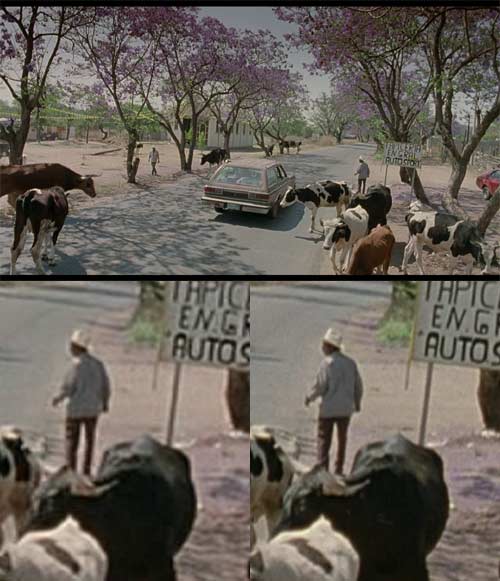Reader James has emailed a very interesting question:
I went to the movies with my 7 year old son and a couple of his friends yesterday to see the new Shrek 3D. I saw the movie at Burwood Greater union in Sydney.
When I got to the titles I took my glasses and was thinking about what you had been talking about with the individual images for each eye and remembered back to the days when they made those “magic eye” books (image link here). The book told you to stare at the dots at the top of the 2D image until you refocused to see the hiddden 3D image. The other technique I learned to see the images was to cross my eyes and then slowly uncross them until i go the 3D image. So I tried this yesterday and it seemed to work. I was able to get the words on the screen to be in focus. Once the image cut to the next title though or there was a lot of movement on screen I lost it and had to start again.
Does the new 3D movie technology use the same basis for the magic eye books? If I were to use the glasses would that mean I could look at a magic eye book and see the images?
As it happens, I had no idea how the pictures in the Magic Eye books worked. But Wikipedia helps. These use one style of ‘autostereogram‘, which is a way presenting two different images — one for each eye — within the one picture, without the need for glasses. The Magic Eye ones use a type of this, called the ‘Random dot autostereogram’, but other forms use more coherent pictures.
Anyone who isn’t familiar with this kind of thing ought to go to the article and click on the picture on the top right.
From memory, the books’ instructions suggested that the viewer should kind of look through the picture, as though looking at something in the distance. This never made much sense to me, but it did work … eventually and uncertainly. I could understand how anyone who hasn’t actually made it work for them would regard this as some kind of weird superstition, like homeopathy, and that people who claimed to see the effect were simply deluding themselves.
Anyway, the reason it didn’t make sense to me was that I was taking the wrong message from the instructions. I was thinking that it had something to do with the depth at which the eyes were focused. But that isn’t the case at all. It all has to do with the directions in which the eyes are pointed.
If you look at something close, your eyes point in a little so that they are both directed at the same point. There is an imaginary triangle with the object being viewed at the apex, and your eyes at the base, looking down the sides. If the object is close, the eyes must angle in quite considerably. Most people can bring them in by thirty degrees or more (look at a finger and bring it slowly closer to your nose).
If you look at something far away, the apex is distant, and the angle away from parallel vision accordingly diminished. At an extreme, they angle in an unmeasurably small amount — ie. they are looking out in a parallel manner.
As Wikipededia explains, but is readily apparent just by trying it out, your eye focus and the swivelling of the eyes according to distance, tend to be somewhat tied together. As it says, autostereograms work if you can decouple the two processes. You actually want to be focused on the item in front of your nose, while having your eyes pointing as though you were looking at a distant scene. This, apparently, is called ‘wall eyed’.
Other autostereograms work in reverse (and some work both ways) by adopting a cross-eyed look.
The aim of all this is for each eye to — yes! — get a different picture to the other.
In a typical cinema you are quite a long way from the screen, so the wall-eyed approach presumably wouldn’t work. But I can imagine that with some material cross-eyed may well do the trick. What’s happening here is that when you look at 3D video material without the eyewear, you are seeing the two pictures merged into one. Autostereogram techniques could possibly permit them to be separated sufficiently again into distinctly different images for the eyes to allow the recreation of the 3D effect.
But I would expect this to work only for simple images (eg. credits). For autostereograms to work, I suspect that complex multi-layered 3D stuff would be too hard for the brain to stitch together in the requisite time period.
Would it work in reverse? Can you use 3D glasses on autostereograms?
No. The movie techniques for separating a single image into two are through different planes of light polarisation (in the cinema), or different images in sequence (3D Blu-ray in the home). An autostereogram doesn’t present either of these.

